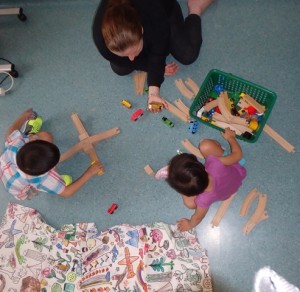This article explores the collaborative work of early childhood teachers as they reconceptualise their multiple roles in the classroom and their impact on children’s learning through play.
Summer vacation provides opportunities to engage in reflection and the planning process which encapsulates deep thinking, learning and understanding about our teaching practices. For us, the early childhood team at Vilnius International School (VIS), it is a pivotal time to construct the next stage of our collaborative inquiry into children’s play. During the 2014-2015 academic year, our work surfaced the complexities of children’s play and the development of our facilitative roles in play intervention. Far from over, the process of reconceptualizing our roles as teachers illuminates the questions: What should we do and when should we do it?
Why focus on play?
As Wood (2011) supports, “although play scholars and practitioners endorse the many benefits of play, practitioners continue to struggle with their provision and in particular, with their roles” (p. 10). Our learning journey has therefore been a foundational stage in reconceptualizing our roles as early childhood teachers as we continuously critique who we are as teachers and what impact that has on learning in the early years.
Supporting our collaborative work, Lynch (2015) concludes that it is not enough to add to the body of available literature which discuss and examine the benefits of play. Focusing on strategies for teachers to implement play is fundamental when it comes to developing more complex forms of play; this is done through the recognition of the teacher as the main instrument to children’s play (Gronlund, 2010). However, what strategies could we use that would illustrate the impact we have on children’s play?
As we inquired into possible strategies, our focus materialized into:
1) intervention stems that we identified as supporting play
2) a collaborative relationship with a research team investigating into play.
As teachers, we are learning to inquire as a team which necessitates a process of negotiation, construction, sharing and re-representation of who we are as early childhood teachers. As a school, we are modelling the kind of learning we expect of our students and forging connections in the local community to further our collaborative work.
Engaging and extending play: Intervention stems
 The first strategy that we undertook as a team was the way we interact with our students at play. Though primacy is given to the role of the teacher in children’s play, the caution is that our involvement does not interrupt the roles, actions and play scenarios created by our students. This consideration resulted in a focus on how we could begin our interaction with our students during play through discussions.
The first strategy that we undertook as a team was the way we interact with our students at play. Though primacy is given to the role of the teacher in children’s play, the caution is that our involvement does not interrupt the roles, actions and play scenarios created by our students. This consideration resulted in a focus on how we could begin our interaction with our students during play through discussions.
How many times do you think a comment hinders or stops the cognitive processes of our learners? This led us to identify and develop intervention stems that could be practiced. The aim of our focus was to practice intervention stems that engage and extend our students. Attention was also given to not inappropriately interfere with play through the use of the intervention stems we identified as interrupting or closing play. It was alarming the number of intervention stems that do not support and extend play and we used them readily. The significance of the intervention stems was to provide us with possible ways to engage with our students and invite responses that reflect what is important to our students at play.
Developing higher levels of play: The role of a play leader
We also had the opportunity to work with a research team from the Play Research Laboratory at the Lithuanian University of Educational Science. The collaboration culminated into three visits from the research team to our school involving purposeful planning and intervention in play through the play leader role. Our collaborative work focused on adult intervention strategies that promote the development of self-regulation whereby children take the lead in planning, organizing and playing.
The reflections from our teachers were that our students began to initiate a continuation of the planned play scenarios on different occasions after the visits. Returning to the purpose of the collaboration, the aim was to use strategies that developed self-regulation so that children would increase their independence in their play activities. The impact was observed by our early childhood teachers as they saw the children’s initiation to restart the planned play scenarios across multiple occasions.
Considerations for further inquiry: What should we do and when should we do it?
The reflections articulated by the teachers after a year-long inquiry serves to inform the future activities of our collaborative work. Specifically, two challenging topics emerged.
The first challenge originated from the idea of timing and time. Play is complex and it became clear through our work that more often than not we intervene too early in some situations while not early enough in others. Factors that make time complicated include scheduling. When we feel pressed for time we tend to prioritize timetabling first. Another factor is conflict – our default as teachers is to quell a conflict, sometimes too early. Finally, time is further complicated by the idea that we value the process over the product. When students are engaged in play that involves creativity, design and challenge it is our overwhelming desire to take over and dictate the correct answer or solution. Therefore we came up with the following question: How do we determine the optimal time to intervene in children’s play?
The second challenge came from knowing how diverse our learners are and being able to meet their needs and interests in a developmentally appropriate way. It became clear when we began exploring our intervention stems that different students require different support. What further complicated the challenge was that our observation, assessment and conferencing became embedded in the play context with multiple players with different purposes interacting simultaneously. This resulted in our second question: How do we balance our multiple and complex facilitative roles more effectively?
The work of children is serious and we are excited about committing to another year where we better determine the ways we can positively impact student learning.
References
Gronlund, G. (2010). Developmentally appropriate play: Guiding young children to a higher level. St. Paul: Redleaf Press.
Lynch, M. (2015). More play please: The perspective of kindergarten teachers on play in the classroom. American Journal of Play, 7(3), 347-370.
Wood, E. (2011). Developing integrated pedagogical approaches to play and learning. In P. Broadhead (Ed.), Play and Learning in the Early Years (9-26). London: SAGE Publications.
—
Jennifer is an early years teacher who has taught in international schools in Asia and Europe. Outside of the classroom, Jennifer is completing her PhD where she is investigating into the diverse factors that impact children’s play in the early childhood classrooms. Jennifer is passionate about unearthing the complexities of play through collaboration and conversation, striving to develop a shared way for thinking, communicating and implementing play in early childhood education at an international level.


Jennifer,
What does the term ”stems” mean?
Thank you for your post!
Brian
Hi Brian,
In our context, we have used “stems” to refer to conversation starters. We recognized the need to be more open-ended and inviting so that the momentum and purpose of the children’s play is not altered through our interaction with them.
Jenny